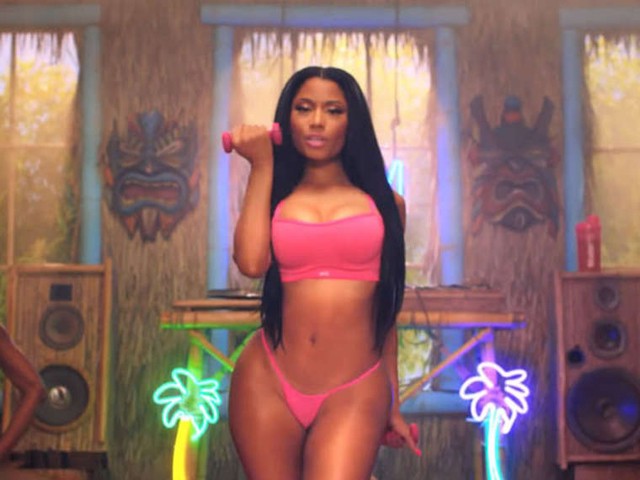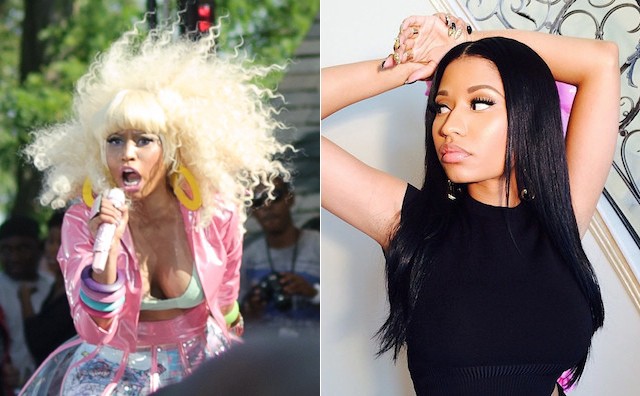I Came Dressed to Kill: Tracking the Nicki Minaj Makeunder
by Julianne Escobedo Shepherd

The cover art for Nicki Minaj’s new single, “Anaconda,” is a backshot of the rapper squatting in a g-string. (Oh: There it is.) The visual was, almost immediately, enough to trigger some paternalistic outrage — for how dare a top rapper bare so much of herself in a genre that is so consistently respectful to women?
Throughout Minaj’s career, I’d argue, every outfit, every shift in aesthetic, has been intentional. The “Anaconda” art is a response to the criticism lobbed toward Minaj from all sides, a retort to those who consistently still say she wears butt pads, or has a fake booty, photoshop be damned. “Anaconda” is an ode to her own ass (née “A$$”) and, by extension, to all the women who have some. The humor to “Anaconda” (“I let him hit it cause he slang cocainnnne,” Minaj raps) might serve to dilute its purpose, but when she outros with “fuck the skinny bitches,” she positions herself quite clearly: this is a song about elevating oft-maligned big booties. She says she’s on some “dumb shit,” but her side-eye on the cover art says all: go ahead and try it.
Moreover, her g-string-and-Jordans look actually highlighted her glorious 2014 makeunder, the makeunder heard round the world. If you’re wondering how a sports bra and a thong constitute a working aspect of a makeunder, note their subdued hue of dusty rose, minimal make-up and accessories, and the newest, most crucial part of her new look: long, straight hair parted in the middle in a perfectly natural shade of ink. And while it seems deeply uncomfortable to “do side bends or sit-ups” with a piece of floss up one’s buttcrack, props for matching her yoga mat, weights, and pilates ball to her ensemble. Before the great Minaj Makeunder, those accoutrements were more likely to be mismatched, neonized, glittery, and outrageous — pop by definition, but a function that served its purpose.
In 2009, when Minaj was still just a mixtape rapper from Queens who’d inked a deal with Lil’ Wayne, she popped a similar squat to her “Anaconda” pic. The parallel underscores how far she’s come, both career- and style-wise, in the past five years. Mimicking Lil Kim’s classic Hard Core-era spread-eagle, Minaj gripped a lollipop and glared seductively into the camera, donning cotton underwear with a waistband that read “sweet” and foreshadowed the candy-colored road paving her future, all the way down to her multicolored pedicure.
That pink bra was the most important thing, though. It became part of her signature look for a good two years, all the way up to Pink Friday. Black top, pink bra peeking out, a natural continuation of her pink highlights (before the early aughties multi-color hair boom [MIXTAPE DROP VOICE: trendsetta!]). Those were the early days of Minaj as Barbie, when she was acquainting her fans with her repertoire of characters and voices, and introducing us to the concept of brassiere layering, which never quite caught on beyond Barbz and those masquerading as Barbz for Halloween. Beam Me Up Scotty had dropped, and she was well on her way to becoming a star — yr girl wrote her first-ever magazine cover story on the topic, holler — but the fashion wizardry had not begun. At the photo shoot for my piece, her stylist had pulled jeans and t-shirts by women’s streetwear companies like Dimepiece. She got her makeup done in her bathroom at the Bowery Hotel with a glam squad that numbered only three. Not six months later, she was stunting in a pink Ferrari with Amber Rose, giving face that would be the first entree into her technicolor, pop-cartoon phase, with a baby-pink braid planted high on her head and military-inspired bustier in pink and green. Barbie was about to get Harajuku on our asses.
Having a signature “look” has been integral to successful pop stardom since a platinum-bleached Madonna first showed up on MTV with piled-on rubber Maripol bracelets and lace tank tops. It’s a warp-speed version of the adage “dress like the person you want to be” — wear clothes that will garner you attention and maybe, just maybe, the pop career will follow. Minaj was distinct before the Harajuku instinct took over, but pink highlights and push-up bra do not necessarily make for the kind of writ-large image that has become so important (for women, anyway). She needed something pop-art, something colorful, something over-the-top: she needed wigs.

One of my favorite photographs in the history of Minaj’s career is that of her attending Carolina Herrera’s Spring 2012 show. The most famous flick from this show is that of Minaj frow’ing next to Anna Wintour, who’d invited her. She matched Wintour’s subdued tangerine brushstroke frock with a top adorned with pom-poms in an outrageously similar hue, and her platinum-blonde beehive brought to mind Lisa-Marie in Mars Attacks.
But it’s not the best picture from that show. The best is the photo of Minaj posing with fashion journalist and icon Lynn Yaeger, who has always championed fashion risks — and practices them herself. Yaeger’s cosign (and subsequent Vogue piece) seemed to me more important than even Wintour’s. (Still, it was Wintour who got the shout-out on “Come On a Cone”: “When I’m sittin’ with Anna, I’m really sittin’ with Anna/Ain’t a metaphor, punchline, I’m really sittin’ with Anna.”) Over the past five years and more, I’d argue — and particularly with the explosion of the celebrity stylist — pop stars have been the only women taking substantial fashion risks, while much of Hollywood shows up to events in one boring-ass gown after the other. Celeb fashion has, on the whole, become safe, and milquetoast, and quite often corporate (spokespeople must wear creations from the design houses they rep, after all). That’s partly why seeing Gaga in a meat dress, or Katy Perry in some kind of proto-rockabilly get-up, or Rihanna in a custom see-through gown with a matching Swarovski du-rag, has elevated these pop stars to style icons. And that’s why Nicki Minaj, in a pom-pom shirt or even a pair of American Apparel disco pants, enthralls us: she has recognized the kind of original character she needs to be, whether Exorcist or mori-style cake-topper.
And if you bring up Gwen Stefani as an originator of “Harajuku” in the States, it’s worth noting that Stefani’s gestures to the stylish region of Tokyo consisted of employing non-speaking Japanese women (ugh) and stamping “Harajuku Lovers” on her tween streetwear. Minaj went full-force with the style, embodying Harajuku as a district and in spirit, flipping kawaii with kei and Lolita and exploding all notions of how a woman in rap was “supposed” to dress, even making trash-bag-era Missy Elliott seem conservative. (Never forget her 2011 VMA look, which was Harajuku dressing to a T, down to the colorful medical mask.) So when she goes back to a g-string and fans grouse, be sure it’s because of her history as an outlandish-style dynamo, but also remember that she’s still bucking notions. Note Minaj’s own fashion line, sold at K-Mart. It’s full of zippered body-con dresses, cute jeggings, and dancehall-queen neons and mesh, and the cut is tailored to short, thick girls: size-large dresses hemmed high for under 5’5″s, lots of give and stretch in the materials for boob and booty. It’s a celebrity fashion line that consciously considers her fans, and though it’s commerce, it feels like love. Those of us who require such a fit are not used to being catered to.
Minaj debuted her makeunder at the MTV VMA Awards in April of this year. Dressed in a minimal black Alexander McQueen gown, she was more understated than she’d been since something like 2009, peeling away the layers to a minimalism reminiscent of fashion’s own transition from ’80s over-the-topness to ’90s Calvin Klein simplicity. At the time I speculated that the shift was tied to her burgeoning film career, though now I’m more inclined to think it’s because she’s just hit that age: the magical time in a woman’s early 30s when she accesses a confidence and self-possession that she had never previously known. In that sense, Minaj’s makeunder seems less about a change in stylists or a shift in musical gears — she’s still “on some dumb shit,” she raps in “Anaconda” — and more about an overall relaxation. She’s attained the pop stardom she so desired, and she may now rest on her talent. For sure she’ll switch it back, and for now she’s not without chutzpah — see: butt. Yet with this funny number and of course her “Flawless” collabo with that other 30-something super-queen, her style forecast is that she’s sitting exactly where she wants to. And if you don’t like it? As “Anaconda” puts it: Gun in my purse, bitch/ I came dressed to kill.
Previously: The Legend of Nancy Silberkleit
Julianne Escobedo Shepherd is a writer and editor in Brooklyn.